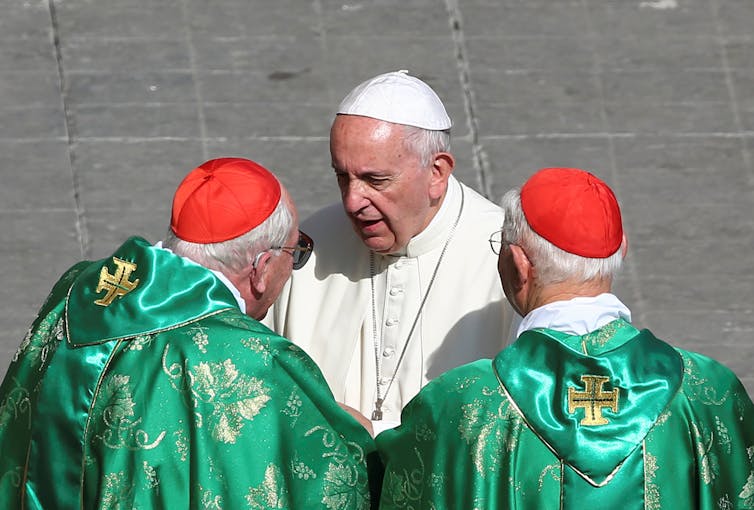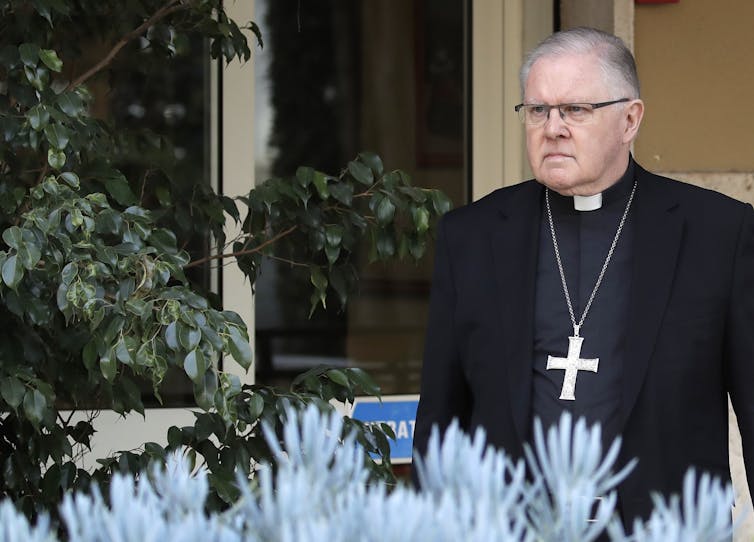After Cardinal Pell’s conviction, can a tradition-bound church become more accountable?
- Written by Mathew Schmalz, Associate Professor of Religion, College of the Holy Cross
A court in Australia recently convicted[1] Cardinal George Pell on charges of molesting two choir boys 20 years ago. Pell is the most senior Vatican official ever to be convicted of such a crime.
The verdict on Pell was announced only days after Pope Francis had concluded a summit of nearly 200 Catholic bishops on protection of minors in the church[2]. It also follows another highly publicized case – that of the former Cardinal Archbishop of Washington, D.C., Theodore McCarrick – who was recently “defrocked”[3] for sexually assaulting minors.
In the United States, reforms[4] have made it mandatory for clergy to report instances of sexual abuse. And in Australia[5], debate rages[6] over whether priests should be forced to break their sacred vows[7] and report child sexual abuse if they learn about it in the confessional.
In the past, the hierarchy of the church has made it hard for cases of clerical sexual abuse to be reported and prosecuted. While Pell got indicted, others got away. And here are some reasons why.
Who is Cardinal Pell?
Once a talented Australian Rules football player, George Pell entered the priesthood and rose to become Australia’s most senior Catholic cleric[8]. He was an articulate advocate for Catholicism and the Christian faith – once even debating atheist author and scientist Richard Dawkins[9]. In 2005, Pell was awarded the Order of Australia[10] as a recognition of his noteworthy contribution to his country.
Cardinal Pell was among the top functionaries at Vatican. He was a member of the “Council of Cardinal Advisors[11],” established by Pope Francis to reform the Vatican bureaucracy. He led the restructuring of the Vatican Bank[12] and served as prefect of the Secretariat for the Economy[13], overseeing all economic activity in the Vatican city state.
Given this distinguished record, Pell’s conviction is especially traumatic[14] for many Catholics. Some commentators[15], and the Vatican[16] itself, still have doubts about whether the Australian court reached a fair verdict.
Church structure
George Pell belongs to a religious hierarchy that is complex and tightly ordered.
At the top of the Catholic Church’s hierarchy[17] is the pope[18]. He is said to be the successor of the Apostle Peter[19], about whom Christ said, “You are Peter and on this rock I will build my church[20].”
For Catholics, the pope is that “rock” that gives the church a firm foundation. The pope is considered to speak infallibly[21], or “without error,” under specific conditions concerning doctrine and morals. But he is not infallible when it comes to choosing advisers and carrying out policy.
 Pope Francis speaks with two cardinals at the Vatican.
Alessandro Bianchi/Reuters
Pope Francis speaks with two cardinals at the Vatican.
Alessandro Bianchi/Reuters
Under the pope are over 5,000 bishops[22], who serve the pope as successors to the original 12 apostles who followed Jesus.
There are also now 214 cardinals[23], who are appointed by the pope. Cardinals under the age of 80 are designated “cardinal electors[24]” and will choose the next pope. Cardinals also govern the church between papal elections.
Cardinals rank higher than bishops, so not all bishops are cardinals. But all cardinals are bishops, although in the past[25] there have been exceptions. George Pell is still both a bishop and a cardinal.
The hierarchical structure of the Catholic Church resembles the military with its high level of administrative control. But the “church” in Catholic understanding is not just a bureaucratic body. It is a sacred institution willed by God.
Priests and obedience
Male priests have the lowest rank in the formal hierarchy. When they are ordained, they take vows of chastity[26] as well as obedience to superiors. Usually priests are under the immediate authority of their local bishop, whose administrative area is called a “diocese[27].”
Although priests in many countries are mandated both by the church and civil law[28] to report sexual abuse to church commissions and legal authorities, a culture of denial and cover-up[29] has prevented allegations from being fully investigated. A 1962 Vatican document instructed bishops to observe secrecy in sexual abuse cases[30] and to address sexual abuse, or “solicitation,” as an internal church matter. German Cardinal Reinhard Marx recently even admitted that the Catholic Church had destroyed documents[31] related to sexual abuse committed by priests.
Despite establishing a commission to look into the problem and address a backlog[32] of cases, Pope Francis[33] has still not established any protocol for handling sex abuse allegations for the Catholic Church as a whole. But the pope has apologized[34] for sexual abuse in ways no other pope has done and has set guidelines[35] for removing bishops who have been “negligent” in addressing cases of abuse.
Still, specifics are lacking, even following the most recent meeting on the protection of minors[36].
Sexual abuse ignored
In the past, the usual response has been to protect Catholic leaders from charges of sexual abuse for as long as possible.
When reports surfaced in 1995[37] that Austrian Cardinal Hans Hermann Groer[38] had molested monks and schoolboys, the sexual abuse was dismissed by Bishop Kurt Krenn[39] as “boyish pranks[40].” There were also claims that victims were paid “hush money[41]” to buy their silence. The allegations of sexual abuse against Cardinal Groer proved to be true.
In another case beginning in the late 1940s, Marcial Maciel[42], the Mexican founder of a religious order, The Legionaries of Christ[43], was a sexual abuser multiple times over. When allegations against Maciel were initially raised, John Paul II ignored them.
In fact, Joseph Ratzinger, John Paul II’s confident and later successor, remarked: “One can’t put on trial such a close friend of the pope[44].” Though Maciel was eventually disciplined[45] by Ratzinger when he took over as Pope Benedict XVI, Maciel avoided prosecution until his death in 2008[46].
In the United States, Cardinal Bernard Law, who protected abuser priests[47] in the Boston archdiocese during his 1984-2004 tenure, also escaped prosecution and died in 2017[48]. Law effectively fled the United States when he was promoted[49] to head one of Catholicism’s most famous churches, Santa Maria Maggiore[50] in Rome.
Challenges to reporting
In all these cases, the hierarchical structure of the church made it difficult to bring high-ranking figures to justice. When superiors are given nearly absolute obedience[51], the threshold for acting against them is high. By the same token, superiors can often protect offending priests.
A presumption of integrity goes with a high position in the Catholic Church. And if the Catholic Church is a divine institution necessary for salvation, there will always be those who will protect its reputation at all costs.
There is a tipping point, however. The key moment leading to the resignation of Cardinal Law was a letter, signed by 58 priests[52], asking him to resign. But in other cases, including that of Cardinal Pell, it seems that media pressure finally forced the Catholic Church to act.
Pell’s conviction, a decisive moment
 Brisbane’s Archbishop Mark Coleridge arrives to read a statement to the media on the conviction of Cardinal Pell.
AP Photo/Alessandra Tarantino[53]
Brisbane’s Archbishop Mark Coleridge arrives to read a statement to the media on the conviction of Cardinal Pell.
AP Photo/Alessandra Tarantino[53]
The compendium of Catholic beliefs, “The Catechism of the Catholic Church,”[54] observes that the “sanctity[55]” of the church is “real” but also “imperfect.” In other words, the church is composed of human beings who have their limitations. From this perspective, the problem is not hierarchy itself, but how people in high positions misuse their power.
All Catholics are aware of the “humanness” of their church, but the conviction of Cardinal Pell is still difficult for many Catholics[56] who expect integrity in their leaders.
Although his bail has been revoked[57], Cardinal Pell will be able to appeal his conviction. Still, Pell may spend the rest of his life[58] in prison. He also faces a Vatican investigation[59] that could lead to his being “defrocked.”
As for the Catholic Church as an institution, many questions will be asked about how – or whether – a tradition-bound hierarchy can become more transparent and accountable.
This piece incorporates material from an article published on Dec. 21, 2017[60].
References
- ^ convicted (www.theguardian.com)
- ^ protection of minors in the church (cruxnow.com)
- ^ “defrocked” (theconversation.com)
- ^ reforms (www.washingtonpost.com)
- ^ Australia (www.thedailybeast.com)
- ^ rages (www.reuters.com)
- ^ their sacred vows (catholicstraightanswers.com)
- ^ most senior Catholic cleric (www.bbc.com)
- ^ debating atheist author and scientist Richard Dawkins (www.youtube.com)
- ^ Order of Australia (www.theguardian.com)
- ^ Council of Cardinal Advisors (www.vaticannews.va)
- ^ Vatican Bank (vatican.com)
- ^ prefect of the Secretariat for the Economy (www.vatican.va)
- ^ traumatic (www.news.com.au)
- ^ commentators (www.firstthings.com)
- ^ Vatican (cruxnow.com)
- ^ hierarchy (www.vatican.va)
- ^ pope (www.newadvent.org)
- ^ Apostle Peter (www.catholic.com)
- ^ You are Peter and on this rock I will build my church (biblehub.com)
- ^ speak infallibly (www.vatican.va)
- ^ bishops (www.catholic-pages.com)
- ^ 214 cardinals (www.catholic-hierarchy.org)
- ^ cardinal electors (www.catholic-hierarchy.org)
- ^ the past (popes-and-papacy.com)
- ^ vows of chastity (www.usccb.org)
- ^ diocese (www.newadvent.org)
- ^ mandated both by the church and civil law (www.usccb.org)
- ^ denial and cover-up (www.theguardian.com)
- ^ secrecy in sexual abuse cases (image.guardian.co.uk)
- ^ destroyed documents (www.cnn.com)
- ^ backlog (www.ncregister.com)
- ^ Pope Francis (www.nytimes.com)
- ^ apologized (theconversation.com)
- ^ guidelines (www.nytimes.com)
- ^ meeting on the protection of minors (www.npr.org)
- ^ in 1995 (www.nytimes.com)
- ^ Hans Hermann Groer (web.archive.org)
- ^ Bishop Kurt Krenn (www.nytimes.com)
- ^ “boyish pranks (books.google.com)
- ^ hush money (www.bishop-accountability.org)
- ^ Marcial Maciel (www.newsweek.com)
- ^ The Legionaries of Christ (legionariesofchrist.org)
- ^ One can’t put on trial such a close friend of the pope (www.theguardian.com)
- ^ disciplined (www.nytimes.com)
- ^ death in 2008 (www.ncronline.org)
- ^ protected abuser priests (www.cnn.com)
- ^ died in 2017 (www.cnn.com)
- ^ promoted (www.wbur.org)
- ^ Santa Maria Maggiore (www.vatican.va)
- ^ obedience (www.vatican.va)
- ^ letter, signed by 58 priests (www.yourlawyer.com)
- ^ AP Photo/Alessandra Tarantino (www.apimages.com)
- ^ “The Catechism of the Catholic Church,” (www.vatican.va)
- ^ sanctity (www.vatican.va)
- ^ difficult for many Catholics (www.firstthings.com)
- ^ bail has been revoked (www.nbcnews.com)
- ^ rest of his life (www.washingtonpost.com)
- ^ Vatican investigation (www.theguardian.com)
- ^ published on Dec. 21, 2017 (theconversation.com)
Authors: Mathew Schmalz, Associate Professor of Religion, College of the Holy Cross


